Overview cooler GlacialTech Siberia - the coolness of the Siberian taiga
In a recent article, we looked at the new GlacialTech Alaska processor cooler. Along with him, another newcomer to the mill of air cooling systems was released - GlacialTech Siberia . Unlike Alaska, Siberia cooler is a member of the cooler family of the TOP design and is equipped with two fans at once. In this article we will see if this helps him to surpass his northern brother.
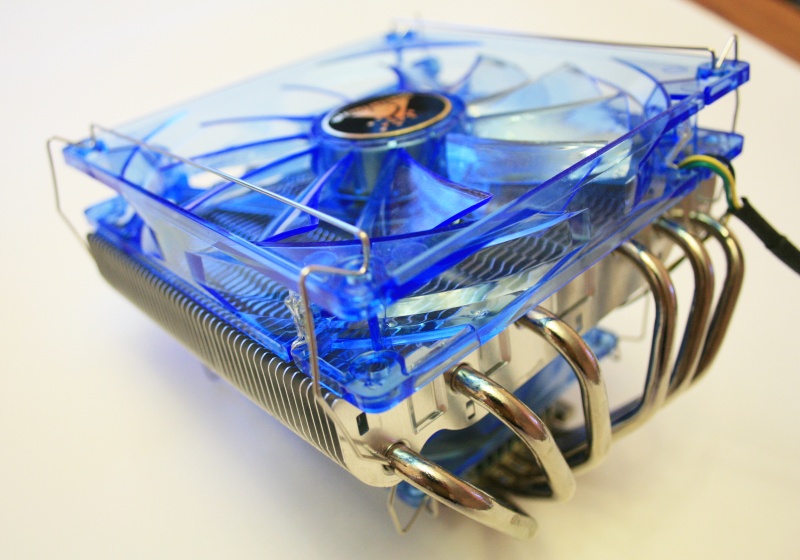
The GlacialTech Siberia CPU cooler is packed in a cardboard box made mostly in black.

The top cover of the box is equipped with a plastic handle, which undoubtedly simplifies its carrying.

The front side of the box has a transparent window through which the main character of this review looks out.
I apologize in advance to the readers for the not perfect condition of the box, which is exactly what I got from the previous tester.

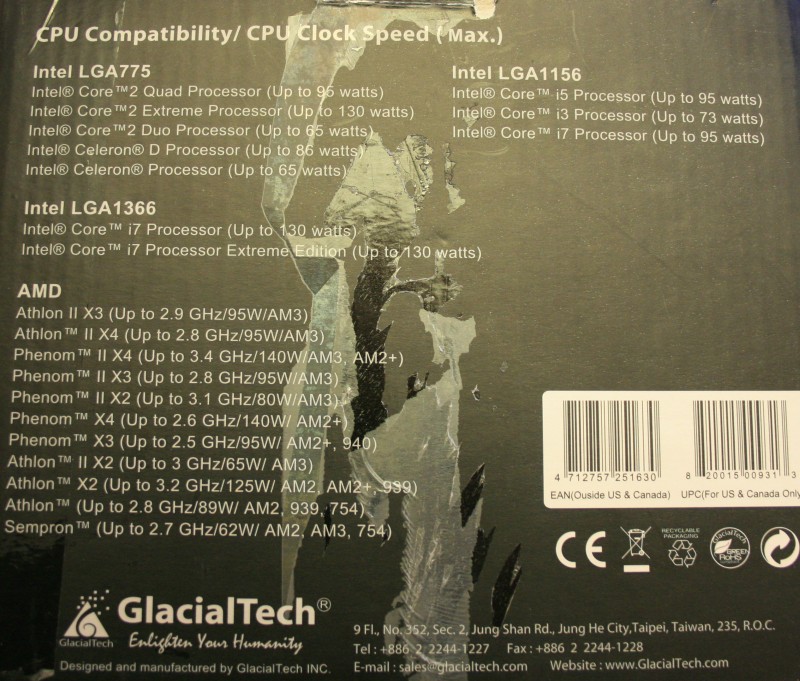

The sides of the box have all the necessary information that can tell the user about the technical characteristics of the cooler and help determine the choice. This information can also be found on the official website of GlacialTech.
The cooler is securely fixed inside the packing box, so there should be no damage during transportation.

The radiator has the overall dimensions of 146x150x120 mm, with a mass of 620 grams. The radiator is based on a copper base, to which six heat pipes with a diameter of 6 mm each are soldered. Heat pipes are "C" -shaped. The number of aluminum plates is 46 pieces, they have a specific shape and are simply strung on the tubes. The thickness of each plate is 0.5 mm, and the distance between them is 2.5 mm.
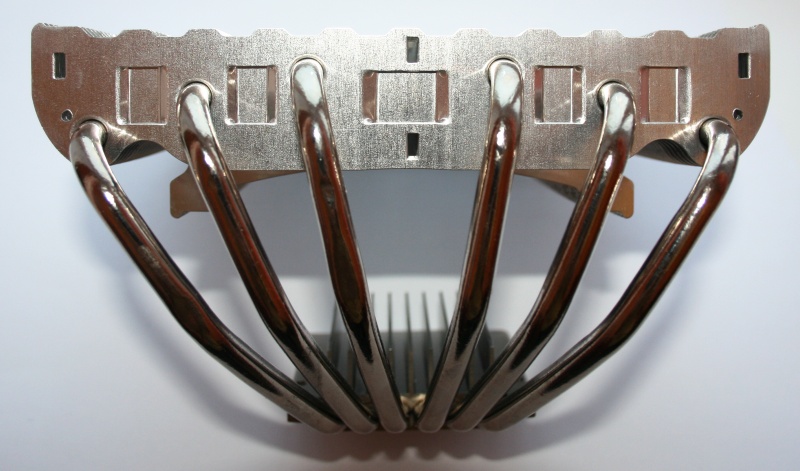
Some semblance of a cellular structure is immediately apparent from the optimizations - five “cells” are squeezed out in each plate. The plates also have perforations in the form of four rectangular holes.
Copper nickel-plated base is equipped with an additional aluminum radiator. The sections of heat pipes passing through the base are laid in the grooves and soldered, which maximizes the contact between the pipes and the heat sink.

The base is not processed in the best way - there are small irregularities to the touch. In this case, there is no question about grinding, much less about polishing.

GlacialTech Siberia is supplied equipped with two fans of various sizes at once.
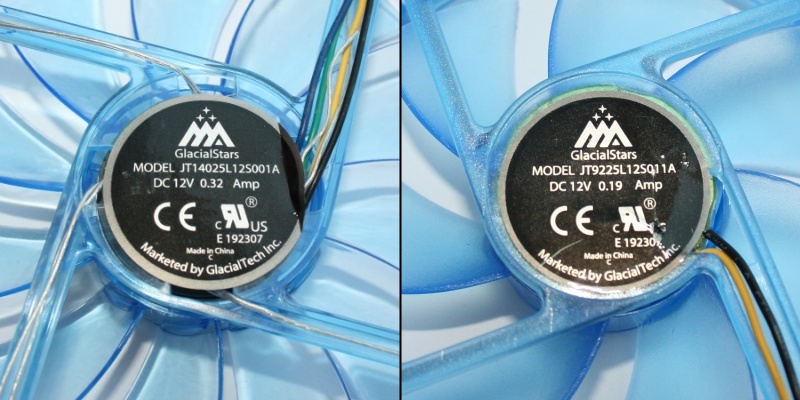
The top fan JT14025L12S001A has dimensions of 140x140x25 mm, whose rotational speed of 11 blades is changed by the PWM method in the range of 800-1400 rpm. Four LEDs of different colors - red, blue, yellow and green - are mounted in the frame. The ability to turn off the backlight is not provided. The bottom fan JT9225L12S011A size 92h92h25 mm has 7 blades, the rotation speed of which is 1300 rpm.

Fans are attached to the radiator with wire clips. The fixing is quite reliable, the brackets securing the lower fan further grasp it in the corners. No anti-vibration strips between the fan and the radiator are provided.
The delivery package is no different from the Alaska cooler kit and still includes a mounting kit, four steel brackets for installing the fans, GlacialTech IceTherm II thermal grease, a spatula for applying it, and a special key for attaching the cooler to the system board. The mount kit consists of three reverse plates (for installing the cooler on Intel LGA775, LGA 1156, LGA 1366 motherboards, respectively), two steel plates, fasteners for AMD platforms, and four spring-loaded screws.
In the dark, the running state of GlacialTech Siberia looks like this.

Agree that some fans of lighting solutions will be satisfied =)
Test configuration and testing methodology
Processor - Intel Core i5 750 ES (2.67 GHz, Lynnfield, rev. B1)
Motherboard - Asus Maximus III Formula (Intel P55, Intel LGA 1156, BIOS 2001)
RAM - Kingmax FLKE86F-B8KJAA, DDR3, 2 x 2048 MB
Video Card - Gigabyte GeForce 9600GT
Power supply - Enermax EMG500AWT (Modu87 +, 500 W)
Storage - SSD Intel X25-V
Cooling System - GlacialTech Siberia
Testing was conducted in the operating system Windows 7.
RealTemp 3.60 was used to monitor the temperature, Everest Ultimate Edition 5.50.2100 fan speed was monitored, and Riva Tuner 2.24c was used to graphically display the monitoring. The load was created using the Linpack - LinX 0.6.4 graphical shell for 15 minutes using all the available memory. The Intel Core i5 750 processor was overclocked to the frequency of 3800 MHz at a supply voltage of 1.35 V. The rotation speed of the fan blades was ~ 1400 rpm. Testing was performed on a horizontal open stand. The temperature in the room at the time of testing was 25-26 degrees Celsius.
')
Test results
Testing was carried out by the LinX utility for 15 minutes. The maximum temperature of the hottest core was 76 degrees Celsius. This result corresponds to the strong middle peasants of the mill CPU coolers.

Comparing the efficiency of both new products, it is clear that Alaska is superior to Siberia under load, the radiator of which is more technologically advanced in terms of applying more different technologies and optimizations.
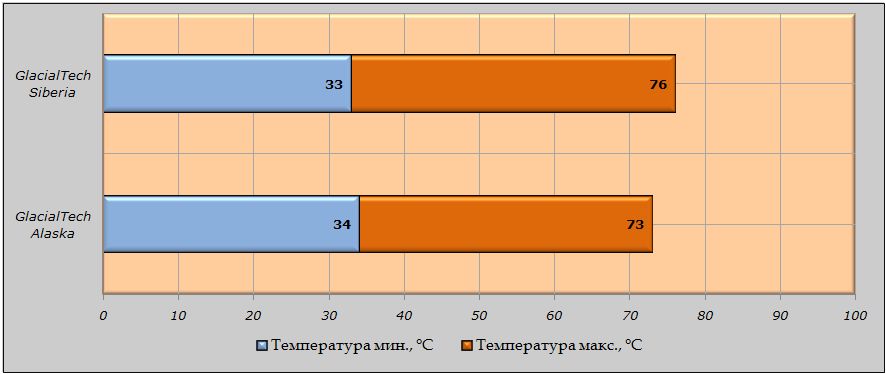
where Temperature min., ° C - idle temperature, Temperature max., ° C - temperature under load.
The company GlacialTech for a long time engaged in the production of inexpensive coolers and presented at about the same time two new products - Alaska and Siberia coolers. Alaska has undoubtedly turned out to be a more successful product: better efficiency, simpler installation on AMD and Intel motherboards allow us to give preference to it.
The Siberia cooler has a lower height, a backlit fan, a TOP design and very little worse efficiency, which certainly will not leave it without attention from a certain circle of users.

The GlacialTech Siberia CPU cooler is packed in a cardboard box made mostly in black.

The top cover of the box is equipped with a plastic handle, which undoubtedly simplifies its carrying.

The front side of the box has a transparent window through which the main character of this review looks out.
I apologize in advance to the readers for the not perfect condition of the box, which is exactly what I got from the previous tester.



The sides of the box have all the necessary information that can tell the user about the technical characteristics of the cooler and help determine the choice. This information can also be found on the official website of GlacialTech.
The cooler is securely fixed inside the packing box, so there should be no damage during transportation.

The radiator has the overall dimensions of 146x150x120 mm, with a mass of 620 grams. The radiator is based on a copper base, to which six heat pipes with a diameter of 6 mm each are soldered. Heat pipes are "C" -shaped. The number of aluminum plates is 46 pieces, they have a specific shape and are simply strung on the tubes. The thickness of each plate is 0.5 mm, and the distance between them is 2.5 mm.

Some semblance of a cellular structure is immediately apparent from the optimizations - five “cells” are squeezed out in each plate. The plates also have perforations in the form of four rectangular holes.
Copper nickel-plated base is equipped with an additional aluminum radiator. The sections of heat pipes passing through the base are laid in the grooves and soldered, which maximizes the contact between the pipes and the heat sink.

The base is not processed in the best way - there are small irregularities to the touch. In this case, there is no question about grinding, much less about polishing.

GlacialTech Siberia is supplied equipped with two fans of various sizes at once.

The top fan JT14025L12S001A has dimensions of 140x140x25 mm, whose rotational speed of 11 blades is changed by the PWM method in the range of 800-1400 rpm. Four LEDs of different colors - red, blue, yellow and green - are mounted in the frame. The ability to turn off the backlight is not provided. The bottom fan JT9225L12S011A size 92h92h25 mm has 7 blades, the rotation speed of which is 1300 rpm.

Fans are attached to the radiator with wire clips. The fixing is quite reliable, the brackets securing the lower fan further grasp it in the corners. No anti-vibration strips between the fan and the radiator are provided.
The delivery package is no different from the Alaska cooler kit and still includes a mounting kit, four steel brackets for installing the fans, GlacialTech IceTherm II thermal grease, a spatula for applying it, and a special key for attaching the cooler to the system board. The mount kit consists of three reverse plates (for installing the cooler on Intel LGA775, LGA 1156, LGA 1366 motherboards, respectively), two steel plates, fasteners for AMD platforms, and four spring-loaded screws.
In the dark, the running state of GlacialTech Siberia looks like this.

Agree that some fans of lighting solutions will be satisfied =)
Test configuration and testing methodology
Processor - Intel Core i5 750 ES (2.67 GHz, Lynnfield, rev. B1)
Motherboard - Asus Maximus III Formula (Intel P55, Intel LGA 1156, BIOS 2001)
RAM - Kingmax FLKE86F-B8KJAA, DDR3, 2 x 2048 MB
Video Card - Gigabyte GeForce 9600GT
Power supply - Enermax EMG500AWT (Modu87 +, 500 W)
Storage - SSD Intel X25-V
Cooling System - GlacialTech Siberia
Testing was conducted in the operating system Windows 7.
RealTemp 3.60 was used to monitor the temperature, Everest Ultimate Edition 5.50.2100 fan speed was monitored, and Riva Tuner 2.24c was used to graphically display the monitoring. The load was created using the Linpack - LinX 0.6.4 graphical shell for 15 minutes using all the available memory. The Intel Core i5 750 processor was overclocked to the frequency of 3800 MHz at a supply voltage of 1.35 V. The rotation speed of the fan blades was ~ 1400 rpm. Testing was performed on a horizontal open stand. The temperature in the room at the time of testing was 25-26 degrees Celsius.
')
Test results
Testing was carried out by the LinX utility for 15 minutes. The maximum temperature of the hottest core was 76 degrees Celsius. This result corresponds to the strong middle peasants of the mill CPU coolers.

Comparing the efficiency of both new products, it is clear that Alaska is superior to Siberia under load, the radiator of which is more technologically advanced in terms of applying more different technologies and optimizations.

where Temperature min., ° C - idle temperature, Temperature max., ° C - temperature under load.
The company GlacialTech for a long time engaged in the production of inexpensive coolers and presented at about the same time two new products - Alaska and Siberia coolers. Alaska has undoubtedly turned out to be a more successful product: better efficiency, simpler installation on AMD and Intel motherboards allow us to give preference to it.
The Siberia cooler has a lower height, a backlit fan, a TOP design and very little worse efficiency, which certainly will not leave it without attention from a certain circle of users.
Source: https://habr.com/ru/post/110495/
All Articles